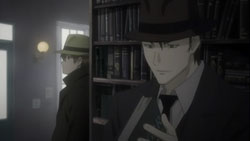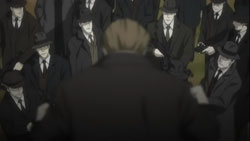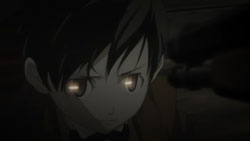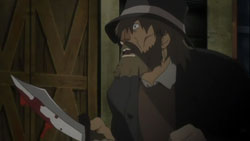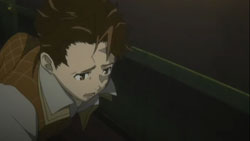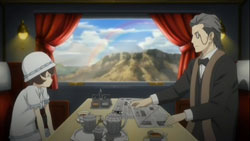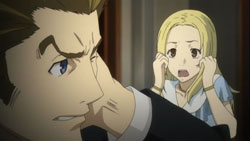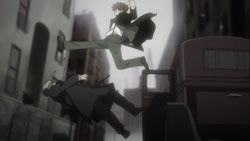 Logo handmade by Bannister
Column by Scott Green
Logo handmade by Bannister
Column by Scott Green
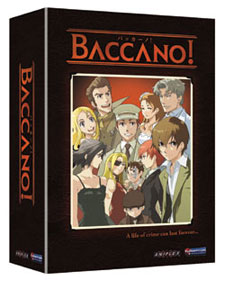

Anime Preview: Baccano! To be Released on DVD by FUNimation January 27, 2009 Preview online at here
Going into the new year, there is plenty of uncertainty regarding the immediate future of anime in North America. Who knows what new titles are going to be able to make it over? Who knows what distributors will still be around? Who knows the role of digital distribution? That said, in terms of recommendations, I'd call Baccano the Ain't It Cool News anime pick for 2009. Like a lot of distinctive, interesting titles, Baccano is anime to share with non anime-enthusiasts. Granted, I'm saying this on a week in which a diverse wealth of anime are being released, from Product I.G's Enlightenment fantasy Chevalier d'Eon to the anime adaption of shoujo pioneer Keiko Takemiya's shounen sci-fi Toward the Terra to the complete collection of Studio 4C's visually inventive take on the magical girl genre, Tweeny Witches, but there is a propensity to produce anime that chiefly appeals to anime fans. The nTh jittery, satirical comedy might be fine, but in recycling the same escapist motifs, anime does not just pigeon hole itself, it side steps the risk and inventiveness that makes anime a vital, exciting medium.Baccano (from the Italian, "noise") shatters a film and constructs a kaleidoscope out of the serialized fragments. Through this fractured lens, it relates a unique circumstance, in which dangerous people bump into each other on the narrow corridors of a train. It's the "black suits," organized fanatics who boarded under the guise of an orchestra, versus the "white suits," literally homicidal maniacs, dressed for a wedding party, looking to make a buck off their thrill kills, versus the "red monster." To really exacerbate the situation, the train is also transporting a pair of gleefully irrational thieves, a senator's wife and daughter, a youth gang lead by a weeping boy with a tattoo of a sword covering half of his face and a young woman with a missing eye and significant burn scarring. The ensemble cast is arranged to form a guns blazing, knifes drawn Rube Goldberg, propelled on the gears of complementary psychoses. Pieces hurl through the deadly cacophony, hoisting the banner of cool as they scrape through with guts, quick thinking and magical booze. In total, it's brilliant escapism. In 1931 a mysterious tragedy befell the Chicago to New York "transcontinental" express train named the Flying Pussyfoot. In 1932, young assistant Carol bounces idea offer her mentor Gustav St. Germaine (if it means anything to you, Norio Wakamoto), also vice-president of newspaper / information brokerage house Daily Days. The pair touch on the causal links, and who might be the hero of the story, as well as whether the antecedents were set in motion in November 1930 or as far back as the 1711 transatlantic voyage of the Avis Advenna. The episode then commences with a stream of images from aboard the Pussyfoot, scenes contemporaneous to its travels, and scenes from its aftermath. These cuts comprise most of the series' work to establish its social context, with visual references to Prohibition bootlegging wars and job lines that aren't necessarily carried throughout the series. There's a running stream of jokes in Baccano where a pair of fools regularly pop in mangle references to Asian culture. The anime affords itself the same privilege in playing fast and loose with American society in the 30's. It has fun with a host of visual motifs and genre touch stones, but it also presents a country devoid of racism, sexism and politics, not to mention populated by individuals with gonzo names like Jacuzzi Splot. A crime family capo is introduced, and assassinated in a hail of bullets. Except for being one of 17 characters named in the anime's opening sequence, the identity of a particular child is not known, but the episode never the less shows him beheaded by a point blank shot gun burst. We see situations that never have a chance to play out over the course of the anime, and the fate of characters beyond what is capture in the finale of the anime's 13 episode run (not counting a 3 episode epilogue, bridge to potential, future adventures). This prologue is essentially a spoiler. Especially with the benefit of hindsight, and factoring in the opening sequence, it gives away almost everything. For example, after this episode the vice-president of the Daily Days is a hidden voice of authority, perpetually obscured by a mountainous stack of papers. The gag plays out despite the fact that he's already been named and seen. It also demonstrates the central conceit of the anime, as well as to whom that conceit applies; a secret that might have been surprising if hidden. Yet, the information is dizzyingly uncollated. It is as if someone did an internet search on a topic of which they had a scant familiarity. They'd be greeted by a flood of information. If they then started reading random passages from that block of information, they'd start establishing a familiarity with the topic. Hopefully, proper introductions and explanations would be nested in that chatter. By the end of the process, even if they continued to grab unassociated pieces of data, they'd be able to piece them into their proper context. This is what Baccano does. It offers specifics, sometime incomplete scenes from 1930, 1931 and 1932 until the whole narrative is unveiled. The most familiar source material for anime to adapt is manga. Then, there's video games, and in recent years interactive fiction visual novels. Baccano was based on a Dengeki Prize winning light novel by Ryohgo Narita. It's been my generalization that anime based on these works of young adult audience prose tend to be concerned with world building or world exploration. They have yielded anime with deep inter-mythologies, like the classic fantasy adventure comedy Slayers or the recent Moribito, as well as anime that are chiefly concerned with examining the works of a place or system like Kino's Journey or Banner of the Stars. The danger in these light novel stories is for an anime series, especially a short one like Baccano, to be swallowed by the need to introduce. Thirteen episode, light novel based series have turned into litanies of new people and places. Baccano script/scenario writer Noboru Takagi has the very underrated sci-fi noir Texhnolyze in his favor, but his reputation also has to contend with his involvement in the anime adaptation of the problematic incest drama Koi Kaze. Baccano's fractured narrative applies a modern framework to the period piece, but it also serves a more practical purpose. With Baccano's alphabet lengthed cast, complex lines of dates and places, it could have been one of those series that got caught up in spending all of its time presenting introductions. Baccano's effect-before-cause structure manages to vitalize the clues, facts and motivations. You see a gallant looking man go feral and begin chanting the names of boxers while punching a gun-man to death, and then you find out this crazy's philosophy and MO. With a right-ordered story, there is a danger that exercising the introduced elements will prove to be less spectacular than the earlier promise might have indicated. By reversing the order, with profile coming after demonstration, the facts are greeted as a compelling points of interest rather than bullet points on an itinerary of upcoming sights. Despite being part of a couple of my favorite mecha OVAs (New Getter Robo, Shin Getter Robo vs. Neo Getter Robo), the production studio behind Baccano, Brains Base, was not on my radar. I was a bit aware that Baccano director Takahiro Omori's last prominent work was Hell Girl, a series that I felt was frequently less clever and visually inventive than its infernal premise promised. Omori had some help on Baccano. Mamoru Kanbe of Elfen Lied (and the darling Robonimal Panda-Z: The Robonimation) had a hand in the particularly catsup smeared episodes. Harume Kosaka (from all over Sailor Moon) had an episode with some interesting face-to-face meetings between notable characters. Jun Kawagoe, of the above mentioned Getter Robo's, got a climatic piece. That said, especially considering my feelings on Hell Girl, I came out of Baccano suprised by how well Omori staged the anime. Omori really bats around the structure of Baccano with flare. The consequences of a particular gunshot in episode 2 aren't revealed until episode 9, and then, it's the third in a rapid succession of takes before the startling action resolves into something with all of the evidence to fully process. Like the larger structure of the anime, the operating pattern of the anime consists of provocative moments, followed by rejoinders. There's a scene of Baccano that opens up to the sight of a mouse, strapped crucified to a table. A shadow looms over it and a hammer begins descending. The anime offers enough time to pull an association without rationalizing the thought before revealing what is actually going on. (Minor side track: I'm not quite sure on the intentions, but there's another interesting associative breath-take in a series epilogue, which peaks forward to New York in 2001. It's telling that despite the anime's frequent, graphic brutality, what it does after that quick thought is whimsically celebratory.) As the director, Omori gets the credit for orchestrating the kaleidoscopic elements of Baccano. He has attention capturing character designs from Takahiro Kishida (Serial Experiments Lain, Spring and Chaos, the lost-classic goof Colorful, the Satelight anime such as Arjuna, Noein) to work with. He has evocatively jazzy music from Makoto Yoshimori. And, key to it all, characters so dripping with personality, that even the idiotic ones elicit a smirk every time there on screen. The way that characters don't simply talk to the screen, the way that they're always doing something, preparing to do something or working something over, the anime always feels coiled, ready to peform something interesting. Especially with its distinctive time, place and situation Baccano is an anime where something exciting could spring like a mouse trap at any moment.
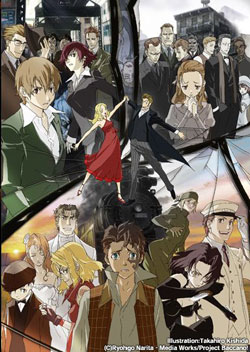
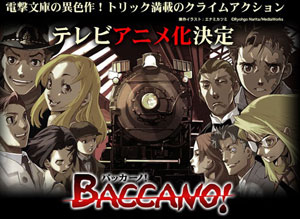
Win a Copy of Osamu Tezuka's Classic Medical Adventure Manga - Black Jack!
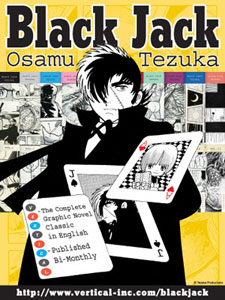

For more commentary see the AICN Anime MySpace.


